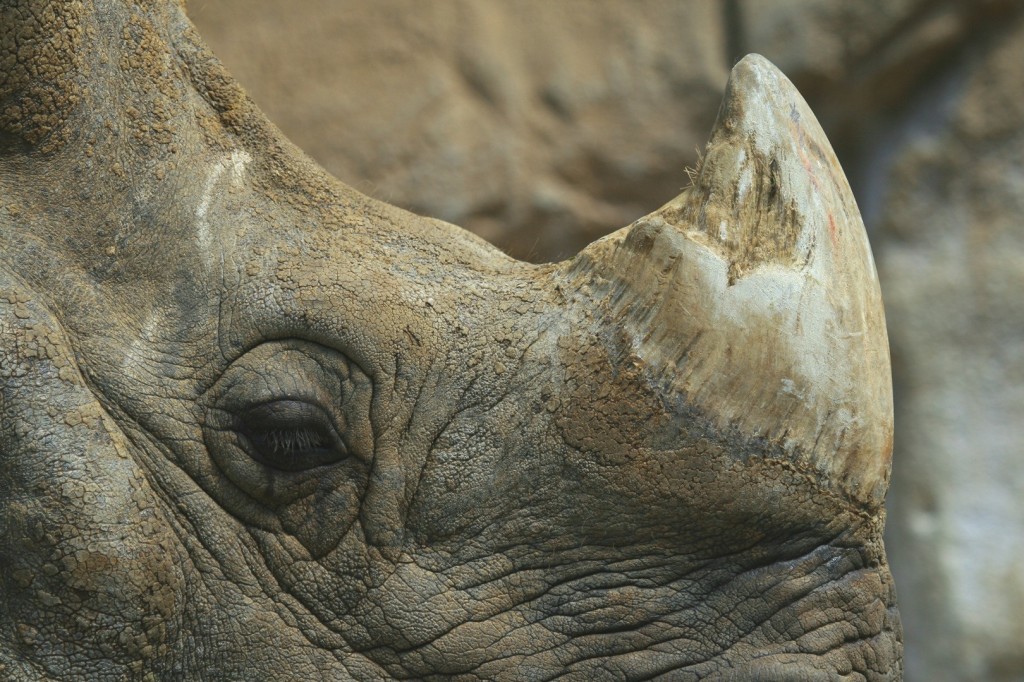No, Legalizing Rhino Horn Probably Won’t Save Animals from Poaching
Legalizing trade didn’t deter poachers from killing more tigers and elephants, and it won’t help the rhinos, either

Photo: Jim Epler
In 2009, wildlife managers across Africa began finding hundreds of rhino carcasses with their horns sawed off. Since then, conservationists have struggled to get a handle on the escalating poaching crisis. Rhino horn can fetch a price exceeding its equivalent weight in gold on the Asian blackmarket, and efforts to stop the determined poachers from stripping rhinos of their valuable horns haven’t had much success so far.
Today, Discover argued that “legalizing the trade in rhino horns may be the best way to protect them from poachers.” The thinking goes like this:
Rhino horns can be cut or shaved without injuring the animals, and they grow back.
The increased supply from legal trade would likely bring prices down, reducing the incentive for poachers to continue slaughtering rhinos. Biggs believes the trade would protect rhinos — a portion of profits could be funneled into continuing to police poachers — and bring jobs to the surrounding areas. And if demand were to keep going up, areas that hold white rhinos could be expanded to grow the population. In the end, a tightly regulated legal horn trade might do the most good.
Now, this is by no means a new idea, nor is it a widely supported one. Officials in South Africa have been arguing the pros and cons of the rhino horn ban for over ten years. Last year, the Cape Times reported on a proposal to lift the 1977 ban in rhino products.
According to the Cape Times, the argument for a monthly, legal rhino horn sale regulated by the government includes:
- Payment would go to rhino owners rather than outlaws
- Horns would be genetically categorized, making their legal origins easily traceable
- The sustainable horn supply flooding the market would reduce incentive for traders to risk breaking the law
But of course there were arguments against the ban too:
- Adding legal rhino horns to the market would only fuel demand
- Criminals would still launder illegal horns and pass them off as legal ones
- Farming rhinos in captivity would make this species akin to domestic livestock and “take the wild out of wildlife”
- This strategy has not worked in the past
- The countries responsible for driving most demand for rhino horn – namely, China and Vietnam – are notorious for their corrupt officials, which doesn’t bode well for enforcing a legal trade
It’s these last two point that is perhaps most convincing. China condones the legal sale of tiger skin and bones, so long as the animals were raised in captivity. But that has done nothing to quell demand for those products, and wild tigers continue to be poached. Conservationist Mark Jones explains in the Huffington Post:
Tigers have fared no better. China has a scheme for registering, labelling and selling the skins from tigers who have died on tiger farms. In spite of a domestic and international ban on the trade in tiger parts, particularly bones, China still allows tiger farmers to breed tigers and store the carcases of those who have died. Meanwhile, wild tigers remain on the brink of extinction with as few as 3,000 remaining in the wild whilst three times that number are estimated to be languishing on Chinese tiger farms.
And this same strategy has been tested a couple times for ivory, too, and it failed to stop elephants from being killed:
On the ivory front, CITES has sanctioned two ‘one-off sales’ of ivory from southern African stockpiles to China and Japan in recent years on the assumption that it will help control or reduce elephant poaching, but it hasn’t worked. Seizures of illegal ivory have risen markedly since the last legal ‘one-off sale’ took place in 2008, with at least 30 tonnes seized in 2011 alone, representing around 3,000 dead elephants. This is probably only 10% to 20% of the total illegal trade. Elephant massacres continue, with hundreds killed in parts of Central and West Africa earlier this year, threatening the survival of whole elephant populations.
In a blog published last year, Mike Watson, CEO of the Lewa Wildlife Conservancy in Kenya, summed up the overall problem with legalizing the trade:
“It might look and sound good on paper and the figures might make sense, but in reality regulating rhino horn and piecing it together at the continental and global level may well prove to be a challenge,” Watson said. “There are so many variables and unknowns that you’ll only know if it’s succeeding if you try it, and if it doesn’t succeed it could be a disaster,” he added.
Ultimately, reducing market demand would be a surefire way to ensure the survival of rhinos, elephants and countless other species, but conservationists are pushing against thousands of years of Chinese culture and tradition. “Until such a time as one reduces the market, we’ll be fighting an uphill battle,” Watson said.
In other words, stopping demand for illegal wildlife goods is the only surefire way to solve the poaching predicament currently threatening wildlife spanning from Asia to Africa. That requires governments to get serious about cracking down on poachers as well as sellers and buyers, and also start pointing out the obvious to their citizens: rhino horn won’t cure your cancer, but it will cause a species to go extinct, and land you in jail.
More from Smithsonian.com:
Investigation: China Covertly Condones Trade in Tiger Skin and Bones
In Vietnam, Rhino Horn Is the Drug of Choice at Both Parties and Hospitals
/https://tf-cmsv2-smithsonianmag-media.s3.amazonaws.com/accounts/headshot/Rachel-Nuwer-240.jpg)
/https://tf-cmsv2-smithsonianmag-media.s3.amazonaws.com/accounts/headshot/Rachel-Nuwer-240.jpg)